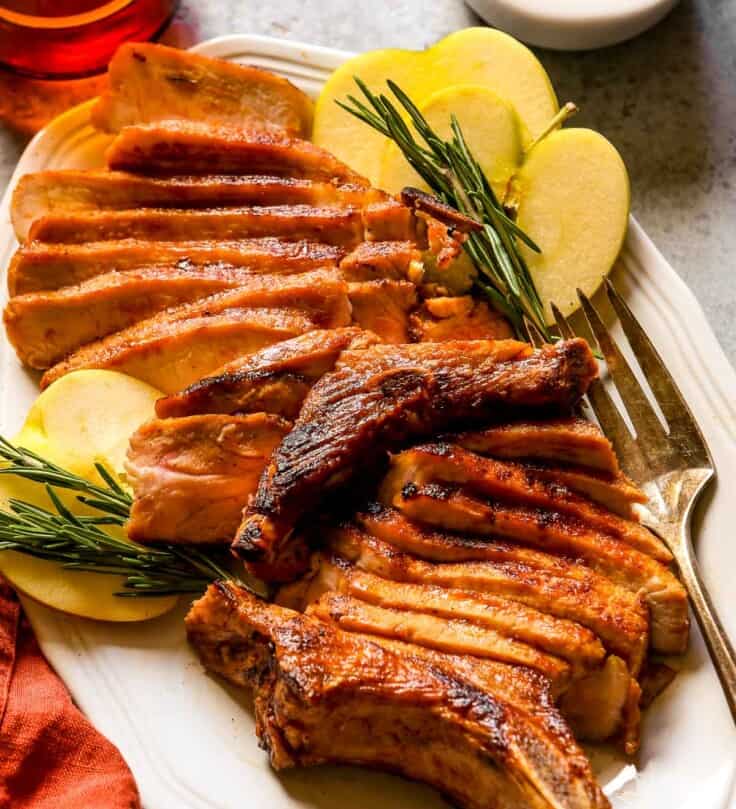Juicy, flavorful chops are possible! This recipe for Brined Pork Chops features apple juice or cider, garlic, rosemary and cloves. Brined for just a couple of hours, the result are two bone-in pork chops that are juicy and flavorful through and through. To bring it across the finish line, I like to brush the chops with a bit of homemade Apple BBQ Sauce.
Table of contents
The Beauty of Brined Pork Chops
Pork chops are infamous for being a bit tricky to cook—they can go from underdone to overdone in a minute. But armed with a simple yet flavorful brine and a thermometer, I guarantee you can cook the perfect pork chop.
The function of a wet brine is simple: absorb and retain moisture and season the meat. Salt plays an important role in the absorbed brine being retained in the meat. And not surprisingly, it also seasons the meat.
Think of a brine as an extra layer of protection or “insurance” when cooking pork chops. Overcook them a tad? A couple of degrees over your targeted temp and they’ll be just fine since you added moisture before you began cooking.
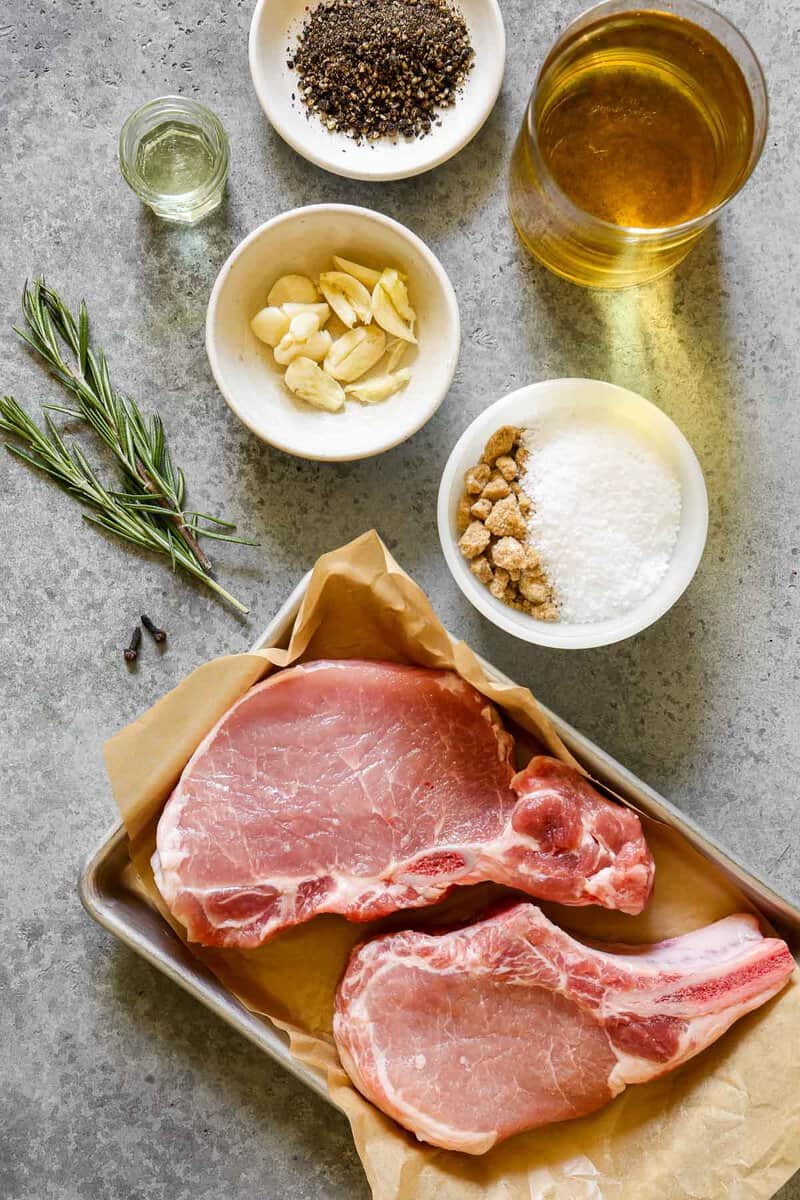
What Goes in a Brine
After a lot of testing, I’ve honed in on the ideal pork chop brine. Here are a few points that are important to know when making a brine:
- You always need salt—I recommend using kosher salt. You’ll be using a lot of salt and if table salt is used the brine will be too salty and likely have an altered flavor. I use Morton kosher salt in my recipe development, so if you are using Diamond Crystal, add a tablespoon more.
- Sugar is optional but recommended—I find brines that contain added sugar are more flavorful and lead to juicier meat. Here I use brown sugar but you can also use regular granulated sugar. Some cooks like to add some molasses too.
- Aromatics—what flavorings you put in your brine is completely up to you. I always like a hearty green herb like rosemary or thyme, black peppercorns, smashed cloves of garlic, and a few whole cloves or star anise.
- Liquid—you can absolutely use water in place of the apple juice in this recipe. The important part is that you use some kind of liquid. I usually prefer apple juice/cider or water. Avoid using broth since you’re already using a lot of salt.
- Don’t add an acid—the first few rounds of testing I added a splash of apple cider vinegar. Not recommended! It makes the meat tough. Skip adding any vinegar or citrus juice to the brine.
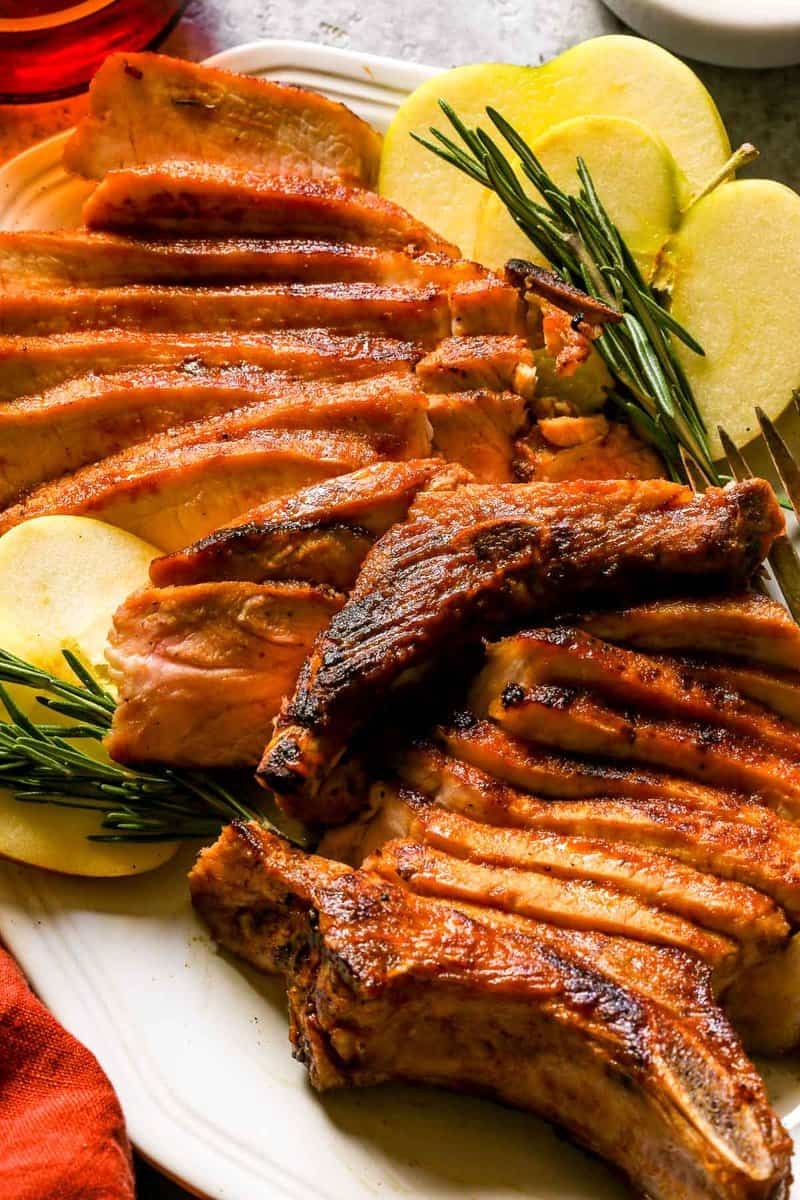
How Long to Brine Pork Chops
When it comes to pork chops, marinate them for a fairly short amount of time. I recommend marinating pork chops for one to two hours—anything longer than 4 hours and the pork becomes tough.
How to Cook Brined Pork Chops
Cooking the perfect pork chop is a dance between brining and cooking to the correct temperature. It’s recommended by the USDA to cook pork to an internal temperature of 145°F (63°C). I recommend taking into account carry-over cooking and removing the pork chops from the heat (in this case the oven) between 130ºF and 135ºF. As the chops rest, their internal temperature will rise to 145ºF.
- Brine
Combine the brine ingredients in a saucepan and bring to a simmer. Cook until the sugar and salt have dissolved. Remove the brine from heat and stir in the ice; set it aside to cool.
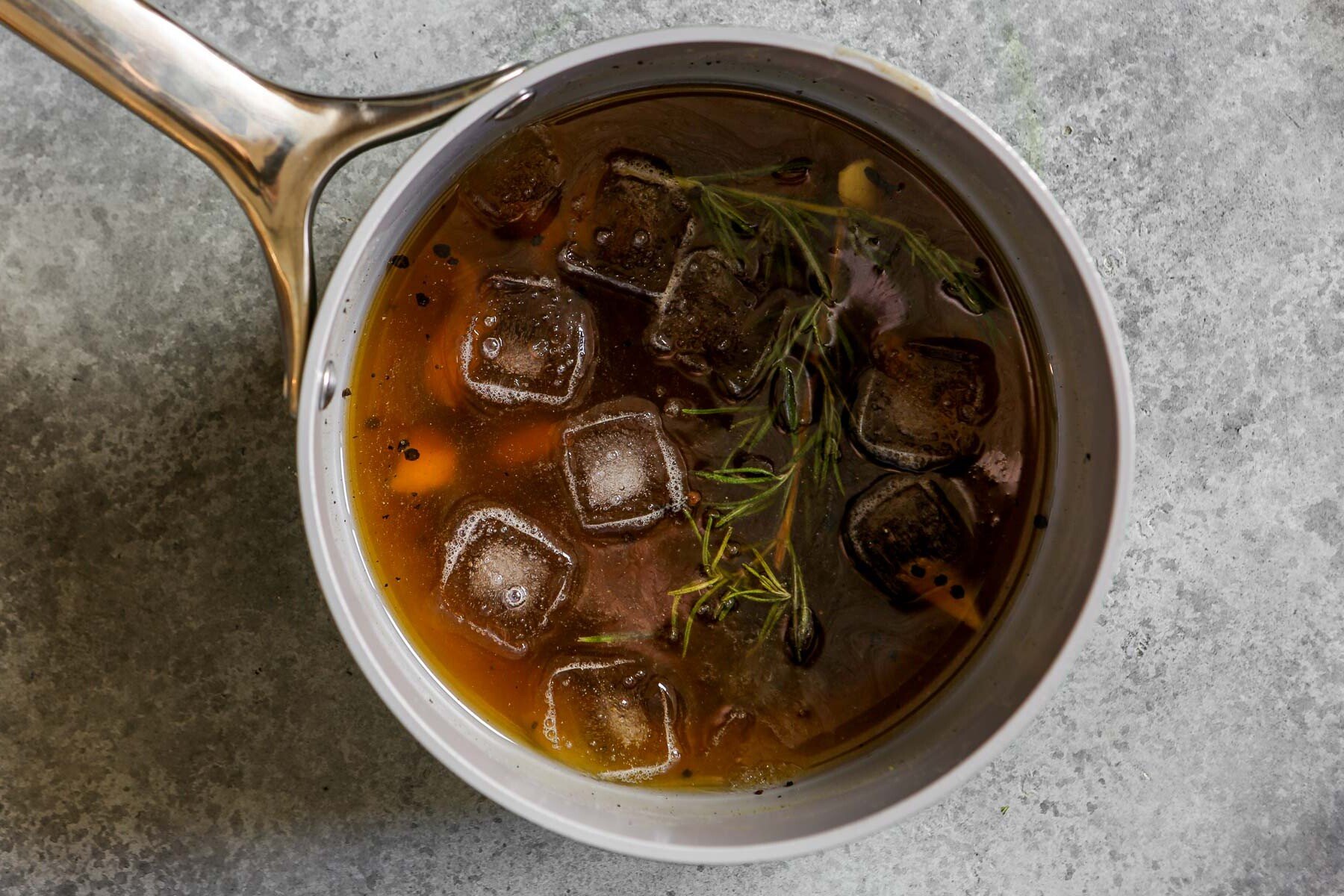
Once cool (it can still be slightly warm, but it shouldn’t be so warm that it will start to cook the pork) transfer the brine to a container with a lid. Add the pork chops, cover and refrigerate for 1–2 hours.
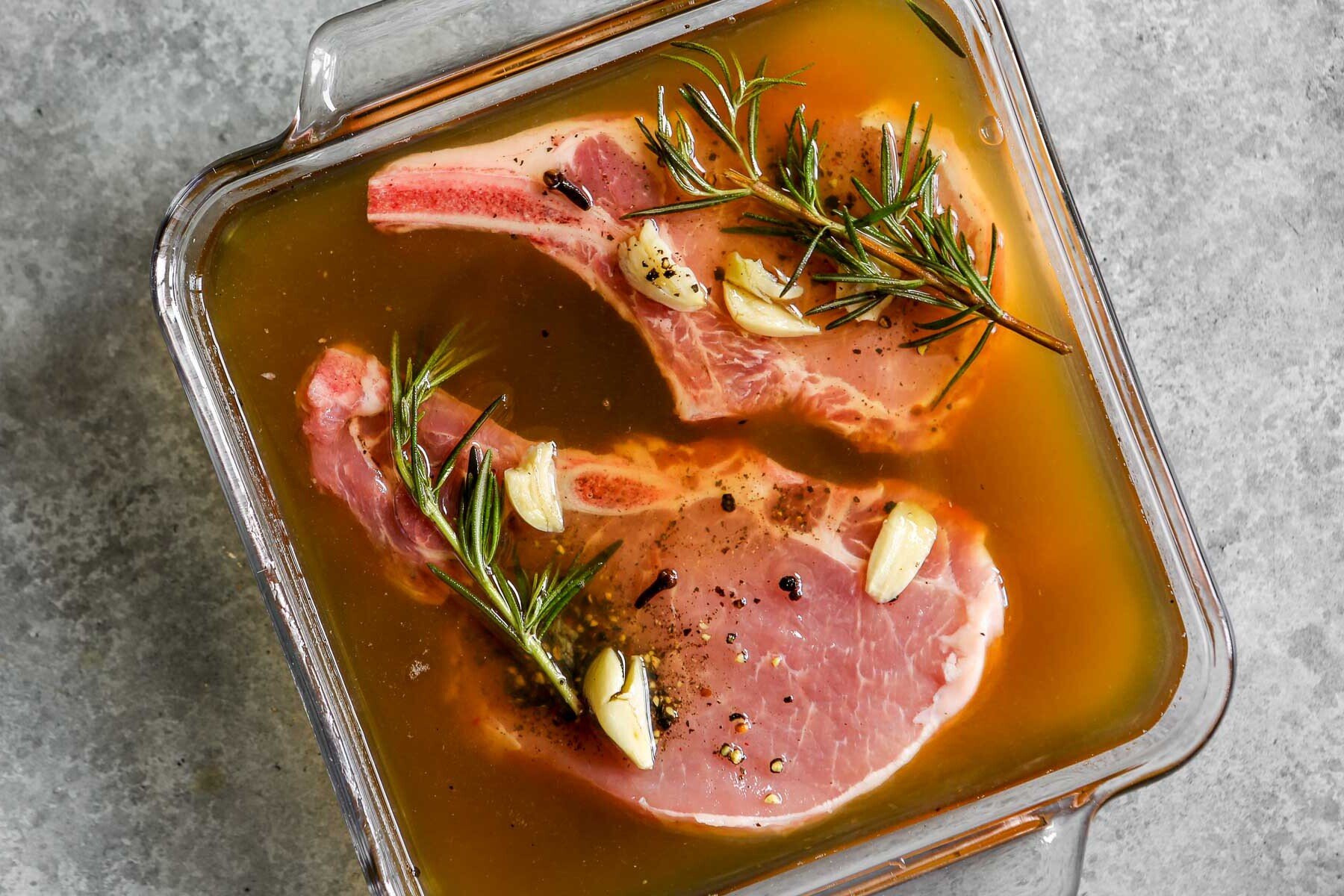
- Sear
Remove the pork from the brine and dry well with paper towels.
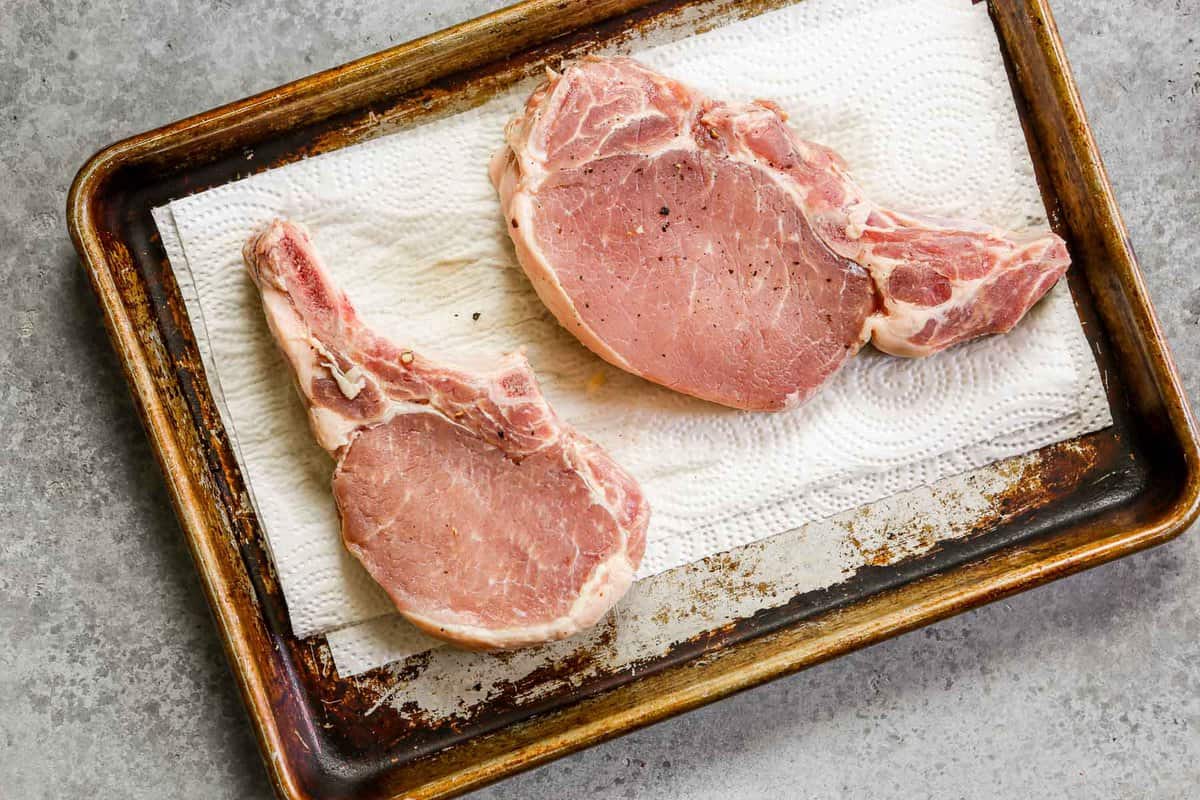
Heat a cast-iron skillet over medium-high for a couple of minutes then add a glug of oil. Place the chops in the skillet and sear 2 minutes. Flip the chops and sear 2 minutes more.
- Finish in Oven
Flip the chops once more then transfer the skillet to the oven. Roast the chops until an instant-read thermometer inserted in the center, but not touching the bone, registers between 130ºF and 135ºF, this will take about 8 minutes.
- Rest
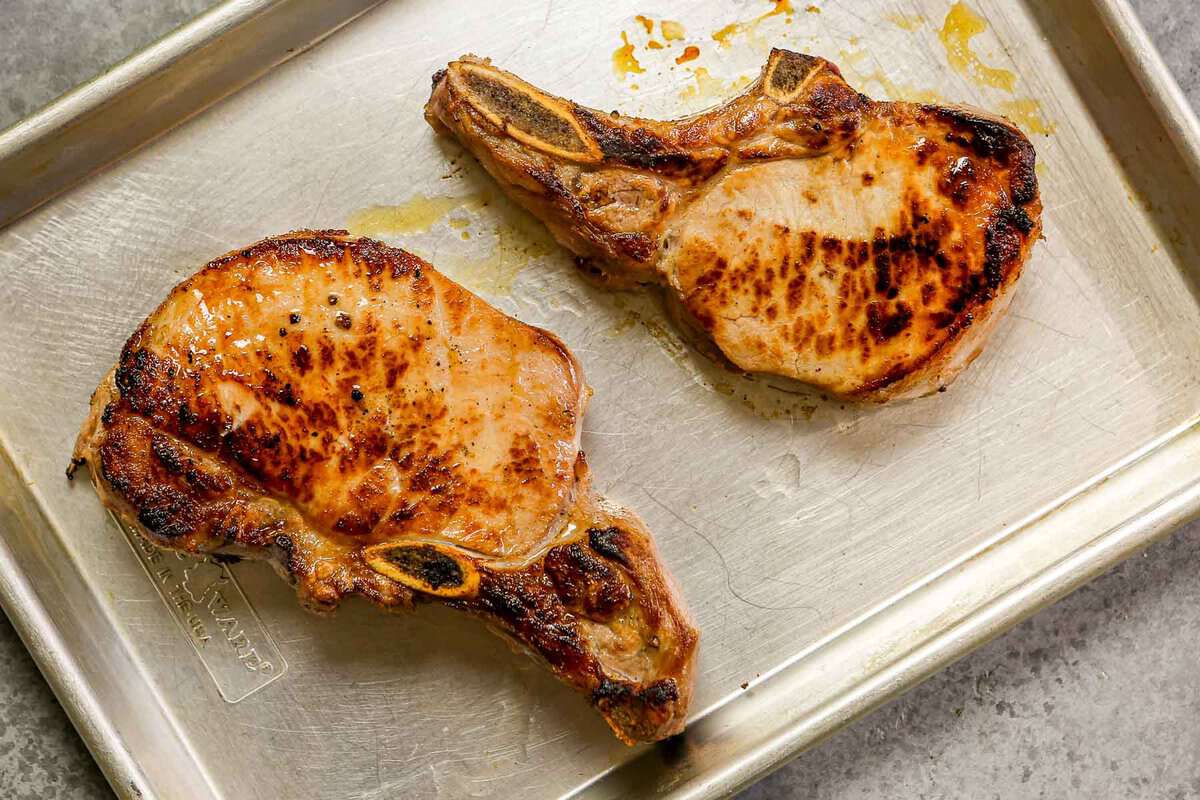
Transfer the pork chops to a cutting board or sheet pan and tent loosely with foil. Let the pork chops rest for about 10 minutes before brushing with barbeque sauce and slicing.
It’s All About Temp
When it comes to cooking meat, I always recommend cooking by temperature, not time. Use timings as a guideline and use temperature as the rule.
Meat should be pulled from heat 5–15 degrees below the desired finished temperature. During resting, the internal temperature will continue to rise, this is called carry over cooking. The amount of carry over cooking that will occur depends on thickness of cut, types of protein and whether or not it has a bone in it.
For thinner cuts of meat, shoot for 5 degrees below ideal finished temperature. For thicker cuts of meat, especially bone-in cuts, shoot for 10–15 degrees below desired doneness.
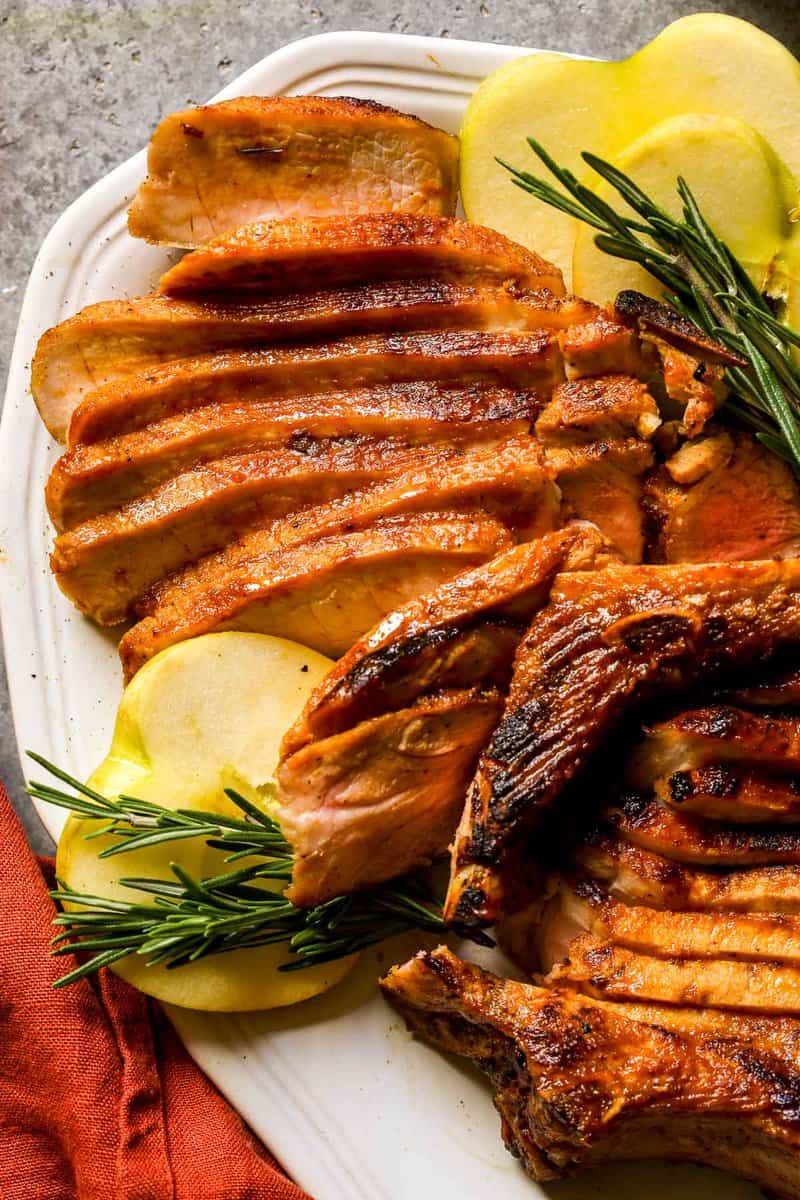
Make it a Meal with These Side Dishes
- A simple 3-ingredient Fennel Salad is the perfect bright side dish to pair with pork. Round out the meal with a hunk of Healthy Cornbread.
- The perfect backyard BBQ dinner consists of pork chops, a Butter Lettuce Salad or Garden Salad, No-Knead Focaccia and a scoop of Mango Sorbet to round it out.
- Keep the oven on and make Roasted Green Beans. Round out the meal with Nut and Seed Bread or Milk Buns.
Brined Pork Chops Recipe
Description
Ingredients
- 2 cups apple juice or apple cider
- ¼ cup kosher salt
- ¼ cup packed brown sugar
- 1 tablespoon black peppercorns, crushed*
- 5 cloves garlic, smashed
- 2 sprig rosemary, roughly chopped
- 2 cloves
- 1 ½ cup ice
- 2 bone-in pork chops (1 ½-inches-thick)
- 1 tablespoons avocado oil or canola oil
- Apple Barbeque Sauce or bottled sauce of choice
Instructions
- Combine apple juice, brown sugar, salt, peppercorns, garlic, rosemary and cloves in a saucepan. Bring to a simmer over medium heat and cook, whisking constantly, until salt has dissolved. Stir in ice to cool mixture. Transfer mixture to a container with lid; add pork chops, cover and refrigerate 1–2 hours.
- Adjust oven rack to lower-middle position and heat oven to 450ºF (232ºC).
- Heat a large cast-iron skillet over medium-high for about 2 minutes. Meanwhile, remove pork chops from brine and pat dry (thoroughly) with paper towels.
- Add oil to skillet and swirl to coat. Once oil is shimmering, place chops in skillet and cook, without moving, for 2 minutes. Flip chops and cook on second side 2 minutes.
- Flip chops once more then transfer to oven; roast chops until an instant-read thermometer inserted in center of each chop, but not touching bone, registers between 130–135ºF, about 8 minutes, turning chops over once halfway through cooking time.
- Transfer chops to a clean sheet pan or cutting board; tent loosely with foil and let rest 5–10 minutes. Internal temperature should increase to 140ºF-145ºF.
- Brush chops with barbeque sauce then slice and serve with additional barbeque sauce.
Equipment
Video
Notes
Nutrition
The Food and Farm Bill
This recipe is sponsored by the American Farm Bureau in an effort to educate Americans on the Farm Bill. I recently had the pleasure of visiting a few farms in Upstate New York and learned how important the farm bill is to securing our food system.
Our first stop on the trip was at the Hudson Valley Research Lab (which works in partnership with Cornell). Here we learned the importance of timely research on things like pests, weather, growing practices, consumer preference, shrinking farmland and more. The laser scarecrow was incredibly interesting to learn about!
From there we headed to Dressel Farms which is where the inspiration for this recipe came from! One thing that really stuck with me was how consumer preferences can impact agriculture.
Farmers and researchers are always working to come up with new varieties that consumers will be interested in while also being a variety that can withstand ever-changing factors such as weather, climate, pests, and more. As of today, there are more than 2500 varieties of apples.
One of the pillars of the Farm Bill is Risk Management, which includes crop insurance. Crop insurance is essential for keeping farmers on their feet when crops are wiped out due to weather or a new pest is introduced to the area (among many other things).
I think it’s important to remember that crop insurance is an integral part of modern farming and is essential for creating a stable food system. The only way to keep farmers farming, is to give them the support needed to weather the bad times and prepare for the next season.
And finally, the bill is often referred to as the Food and Farm Bill because 80% of the farm bill is dedicated to nutrition and education programs. These programs include making healthy foods more accessible for seniors, Veterans, those with disabilities, and more.
And milk is one of those foods! We had the pleasure of visiting Dutch Hollow Farms where we learned all about Jersey cows, how dairy farms operate, and what kind of lifestyle it takes to run a family-owned and operated dairy farm for generations. It’s an around-the-clock operation that takes true dedication.
At the end of the day, we should all know that farm and ranch families comprise less than 2% of the U.S. population but account for 90% of total agricultural production value. These are real people, real families, feeding our country and caring for our land. I have never met someone who loves our planet like a farmer does. This bill is not just important for farmers, it’s important for every American.
Learn more about the farm bill today!
